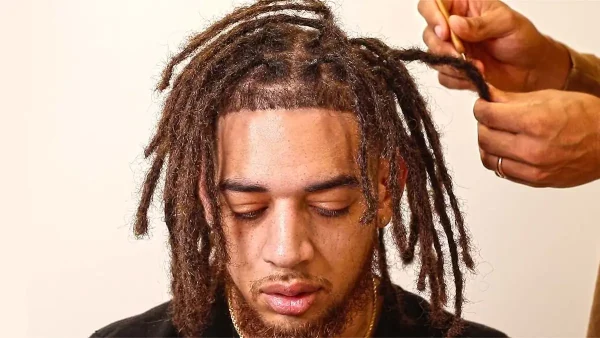
Locs are eye-catching, exotic, and edgy. At the same time, they are misunderstood. This hairstyle represents our personality, culture, and personal taste. For some, locs are spiritual, while it means inner growth for others. A wide range of methods is available for creating locs, including back-combing, twist and rip, freeform, and many more. This comprehensive guide focuses on the freeform method. Read it carefully and learn the benefits of not retwisting locs.
Benefits of Not Retwisting Locs
Ease of use and simplicity are the biggest benefits of not re-twisting locs. More importantly, you will need to mess with your hair while following the other methods. But this method will give you lots with minimal effort.
Not Retwisting dreadlocks is the simplest and completely natural method. This process is often associated with a holistic or natural lifestyle. In this method, people leave their natural hair afro until it dreads on its own.
2 Months No Retwist
The 2 months of the no retwist locs development is known as the “baby stage.” Your hair will entirely get coiled from roots to ends in this period.
Generally, starter locs are smaller in size, making them easy to identify.
Starter Locs Maintenance Tips:
- Wait a minimum of 2 weeks before the first shampoo
- When your locs get dirty, cleaning will be necessary. Remember to choose a residue-free shampoo for washing
- Scalp and baby loss need to be moisturized. For this, apply conditioner regularly
- Avoid detangling them
- Let your locs grow on their own
3 Months No Retwist
At a 3-month stage, the coil of the locs will become thick. This is crucial because weak spots and bumps may build up if you don’t consistently and thoroughly clean your hair by shampooing. This stage is also called “sprouting” or “budding.”
Usually, sprouting locs are swell and frizzy in size.
Budding Locs Maintenance Tips:
- Daily cultivating and cleaning your hair is mandatory
- Regular shampooing is also necessary, don’t unravel your hair
- Don’t twist your budding locs. This will lead them to death
- Stop twisting your locs frequently. It can cause thin loss and breakage
4 Months No Retwist
After 4 months, you enter the teen phase or locking stage. Some refer to it as an ugly phase. This is an exciting stage since your buds and sprouts will look like locs during this time. Moreover, you can style your hair according to your choice by investing in accessories. As the growing stage is already finished, shampooing will not hamper.
Teen Locs Maintenance Tips:
- While selecting the shampoo and conditioner, be highly selective to avoid buildup as your locs are just beginning to lump
- You can do some experiments in this stage by pressurizing your hair
- Regular washing is required to keep your hair moisturized
5 Months No Retwist
Your excitement will be higher in this stage because the loss will be noticeable in length, and minimal frizz will be there. It is called the mature stage, and your locs are close to the end. After this stage, no reforming is there.
Mature Stage Maintenance Tips:
- Regular shampooing and conditioning is necessary for this stage
- Using the ideal product is crucial. If you don’t do so, buildup will ruin the whole process
- Never think of re-twisting your hair at this stage. It can damage your locs
6 Months No Retwist
So, you are at the 6 months of no retwist process. Typically, your locs have all grown to the same length. At the same time, they will feel heavier. If you want an effortless style, trim them if necessary. You also can choose them to grow as much as possible.
Rooted Phase Maintenance Tips:
- Keep your hair moisturized by using natural oils like Argan oil and Avocado oil. Also, your locs will look shiny
- Avoid deterioration at the ends of your locs by regular trimming
- Every 1-2 weeks, ensure deep conditioning
- Make sure to dry your lock thoroughly. It will prevent odor effectively
No Retwist For a Year
Hopefully, by now, you have already achieved locs without retwisting. In this stage, you need to take proper care of your dreads by washing and shampooing daily. Remember to provide an air-dry because it will ensure the good health of your locs.
To sum up, the benefits of not re-twisting locs are:
- A mess-free method with your hair
- Requires minimal effort to get the dreads
- Easy and hands-free way
- inexpensive
How Long Can You Go Without a Retwist?
Technically, you can go as much as you can without a retwist. However, the frequency of re-twisting depends on the mature locs phase, hair, and locs type. It would be best to go as long as 8 weeks without re-twists.
Is it Necessary to Retwist Locs?
While your dreads are developing, retwisting is necessary. The necessary process needs to be followed, otherwise, your dreads will get damaged.
Frequently Asked Questions About Benefits of Not Retwisting Locs
1. What are the benefits of not retwisting locs?
Not retwisting locs allows them to mature naturally, resulting in thicker, more robust locs over time. It also reduces the risk of breakage and scalp tension caused by frequent manipulation.
2. Does not retwisting locs affect the appearance of locs?
Initially, not retwisting locs may result in a less manicured appearance, with some frizz or loose hair at the roots. However, over time, this approach can lead to the development of fuller, more textured locs with unique character and personality.
3. How often should locs be retwisted?
The frequency of retwisting varies depending on individual preferences and hair texture. Some people retwist their locs every few weeks, while others opt for less frequent retwisting or choose not to retwist at all.
4. Does not retwisting locs make them harder to maintain?
Not retwisting locs may require a different maintenance routine compared to regularly retwisting. This may involve methods such as palm rolling, interlocking, or simply allowing the locs to grow and mature naturally. With proper care and maintenance, locs can remain healthy and manageable without frequent retwisting.
5. Does not retwisting locs result in more buildup or dirt accumulation?
While not retwisting locs may lead to some buildup at the roots over time, regular cleansing and maintenance can help mitigate this issue. Using natural shampoos and avoiding heavy products can also prevent excessive buildup and keep locs clean and healthy.
6. Can not retwisting locs lead to thinner or weaker locs?
Not retwisting locs does not necessarily result in thinner or weaker locs. In fact, allowing locs to mature naturally can promote stronger, thicker locs over time. However, proper care and maintenance, including regular cleansing and moisturizing, are essential to maintaining healthy locs regardless of retwisting practices.
7. Are there any cultural or spiritual reasons for not retwisting locs?
For some individuals, not retwisting locs aligns with cultural or spiritual beliefs related to embracing natural beauty and allowing hair to grow freely without excessive manipulation. Additionally, not retwisting locs may symbolize a deeper connection to one’s roots and heritage.
Conclusion
It is important to know the dreading method before deciding to go for it. The whole dreading process can take 6 – 12 months. During this time, you must maintain the process tips meticulously to achieve the benefits of not re-twisting locs.
Once you successfully complete the whole process, no other things can keep you waiting to have the long, thick, and shiny locs you desire.

Leave a Reply